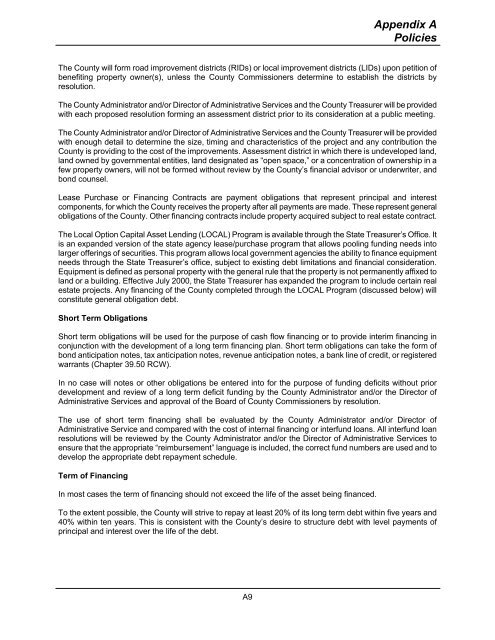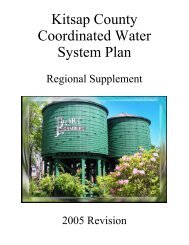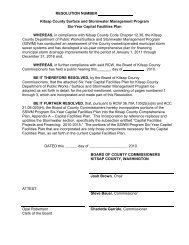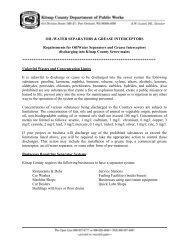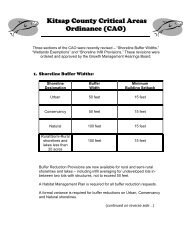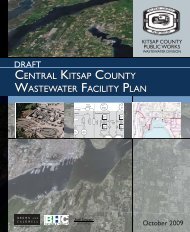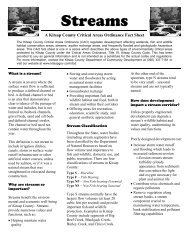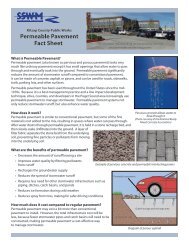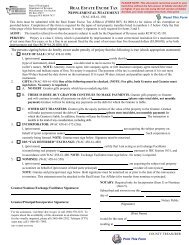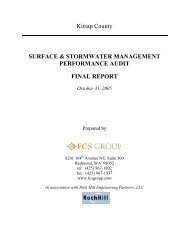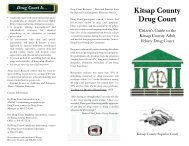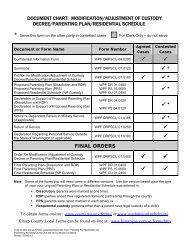2008 Budget Book - Kitsap County Government
2008 Budget Book - Kitsap County Government
2008 Budget Book - Kitsap County Government
You also want an ePaper? Increase the reach of your titles
YUMPU automatically turns print PDFs into web optimized ePapers that Google loves.
Appendix A<br />
Policies<br />
The <strong>County</strong> will form road improvement districts (RIDs) or local improvement districts (LIDs) upon petition of<br />
benefiting property owner(s), unless the <strong>County</strong> Commissioners determine to establish the districts by<br />
resolution.<br />
The <strong>County</strong> Administrator and/or Director of Administrative Services and the <strong>County</strong> Treasurer will be provided<br />
with each proposed resolution forming an assessment district prior to its consideration at a public meeting.<br />
The <strong>County</strong> Administrator and/or Director of Administrative Services and the <strong>County</strong> Treasurer will be provided<br />
with enough detail to determine the size, timing and characteristics of the project and any contribution the<br />
<strong>County</strong> is providing to the cost of the improvements. Assessment district in which there is undeveloped land,<br />
land owned by governmental entities, land designated as “open space,” or a concentration of ownership in a<br />
few property owners, will not be formed without review by the <strong>County</strong>’s financial advisor or underwriter, and<br />
bond counsel.<br />
Lease Purchase or Financing Contracts are payment obligations that represent principal and interest<br />
components, for which the <strong>County</strong> receives the property after all payments are made. These represent general<br />
obligations of the <strong>County</strong>. Other financing contracts include property acquired subject to real estate contract.<br />
The Local Option Capital Asset Lending (LOCAL) Program is available through the State Treasurer’s Office. It<br />
is an expanded version of the state agency lease/purchase program that allows pooling funding needs into<br />
larger offerings of securities. This program allows local government agencies the ability to finance equipment<br />
needs through the State Treasurer’s office, subject to existing debt limitations and financial consideration.<br />
Equipment is defined as personal property with the general rule that the property is not permanently affixed to<br />
land or a building. Effective July 2000, the State Treasurer has expanded the program to include certain real<br />
estate projects. Any financing of the <strong>County</strong> completed through the LOCAL Program (discussed below) will<br />
constitute general obligation debt.<br />
Short Term Obligations<br />
Short term obligations will be used for the purpose of cash flow financing or to provide interim financing in<br />
conjunction with the development of a long term financing plan. Short term obligations can take the form of<br />
bond anticipation notes, tax anticipation notes, revenue anticipation notes, a bank line of credit, or registered<br />
warrants (Chapter 39.50 RCW).<br />
In no case will notes or other obligations be entered into for the purpose of funding deficits without prior<br />
development and review of a long term deficit funding by the <strong>County</strong> Administrator and/or the Director of<br />
Administrative Services and approval of the Board of <strong>County</strong> Commissioners by resolution.<br />
The use of short term financing shall be evaluated by the <strong>County</strong> Administrator and/or Director of<br />
Administrative Service and compared with the cost of internal financing or interfund loans. All interfund loan<br />
resolutions will be reviewed by the <strong>County</strong> Administrator and/or the Director of Administrative Services to<br />
ensure that the appropriate “reimbursement” language is included, the correct fund numbers are used and to<br />
develop the appropriate debt repayment schedule.<br />
Term of Financing<br />
In most cases the term of financing should not exceed the life of the asset being financed.<br />
To the extent possible, the <strong>County</strong> will strive to repay at least 20% of its long term debt within five years and<br />
40% within ten years. This is consistent with the <strong>County</strong>’s desire to structure debt with level payments of<br />
principal and interest over the life of the debt.<br />
A9


